Where travel agents earn, learn and save!
News / Aviation 2020 to 2030. A COVID reality check for airlines
2021's airline revenue pool will be less than half of 2019's

November 30 - It is time the industry and governments faced up to the fact that restoring the status quo ante is no longer an option.
This was the key takeaway from the introductory presentation at CAPA Live on November 11, 2020.
As we look ahead through the next decade, it is time for a reality check - a reality check nine months on from when the horrible COVID-19 disaster beset the world, in turn looking at a new platform for building for the next decade.
That is to say, the new starting point as 2021 beckons.
What will be the platform for the future growth? And what will shape that growth as industry revenues slump by more than half 2019 levels in 2021?
The following is a lightly edited version of a presentation by Peter Harbison, CAPA Chairman emeritus, talking at CAPA Live on November 11, 2020.
Today, I want to have a good look through the next decade, an optimistic goal, given that we don’t really know from one day to the next what’s going to happen.
But it is time, first, to have some sort of reality check
That is, a reality check nine months on from when this horrible coronavirus disaster beset the world, in turn looking at a new platform for building for the next decade. That is to say, the new starting point.We’re literally only a few weeks away from the end of the year and the beginning of a new one, which hopefully will be a lot better than this. But what do we do when we go into 2021? What’s the new situation going to look like?
In other words, what will be the platform for the future growth?
I think most people realize now – unless they’re really deluding themselves – that what comes next must become a structurally very different industry.
A smaller revenue pool implies fundamental change
For example, IATA calculated just recently that the size of the revenue pool for airlines globally will be about half of what it was in 2019. That means massive change.It’s really important to get that to sink in.
Costs will need to be downsized. And airlines have been doing that all through this year, obviously in very important ways. But to reduce costs by half is impossible, without a drastic change in profile.
And I think even that 50% revenue drop is probably optimistic. If you look at it in a granular way: let’s say if we are operating with 70% load factors next year, if yields are as high as 70% of 2019’s… and capacity is down to about 70% of where it was last year – each of them optimistic from where we stand now.
Even an “only” 50% drop is optimistic

That combination would give you an outcome of about one third of the gross revenue of 2019 over the full year. And given that we’re now into lockdown in Europe, and that the US probably is going to have to confront something like that in the near future, we will not be off to a flying start on January 1, 2021.
And a lot of other markets are really looking pretty wobbly.
So, in reality we’re looking at somewhere between a third and a half of revenues for the entire market for the full year 2020.
So as IATA asks again: can even cash break-even be achieved in 2021? That is to imply, further losses will almost inevitably be incurred over 2021.
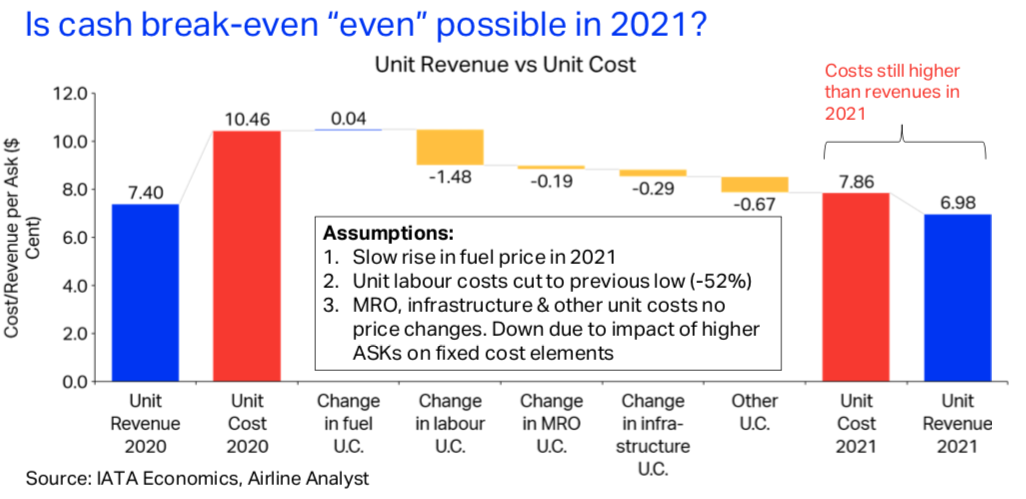
The blue bars at the either ends of this slide are the unit revenues for 2020 and (projected) 2021. And you can see, even a relatively modest drop there between USD7.40 cents to USD6.98 cents in terms of revenues is going to drive a very substantial gap between cost and unit revenue – even with a large reduction in costs.
In other words, every revenue kilometre flown is going to be losing money. As a result of that, unsurprisingly, IATA would suggest that some airlines are going to run out of cash fairly soon.
And this next graph was actually produced two months ago before the new waves of infection occurred.
So, it’s probably going to be even tougher than that.
Not just an incremental shift – a fundamental decline
Our aim is not to dwell too much on the negatives. But it's important I think to recognize what the new shape of the airline industry will look like.
We’re heading into a revenue funnel
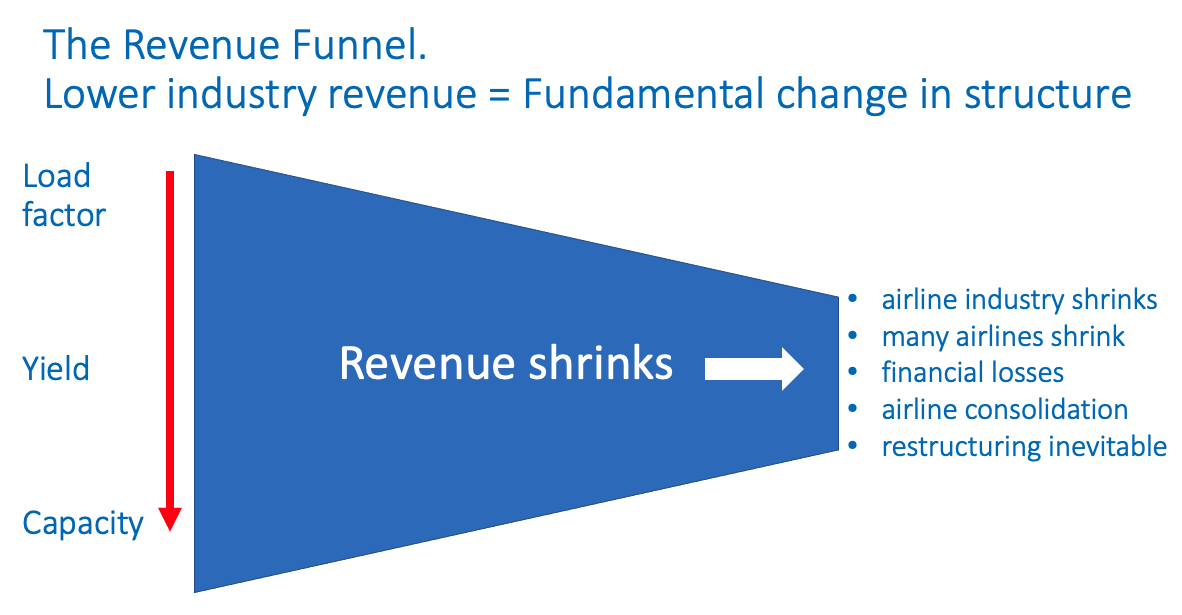
Revenue is going to reduce in size from somewhere between a third and a half of 2019 levels. And that delivers more than an incremental shift – it delivers a fundamental decline.
If we’re going to have a drop somewhere between about a third to a half of last year’s revenue, we will need to be looking at some sort of fundamental change in structure of the industry.
• It’s not going to be just an incremental adjustment. It’s a fundamental change
• So, digesting that, the airline industry itself has got to shrink
• Many airlines themselves have shrunk already; and they will stay shrunk
• There’ll be much more in financial losses
• Airline consolidation is inevitable, including airline departures and restructuring, the keyword in this – a fundamental restructuring
• That implies not just adjustments to cost, which is really where we’ve been focusing until now
That has been very painful – but there has still not been any elemental adjustment in the approach being taken to where we need to be for the next decade; that is, the ingredients of the 2030 scenario.
Let’s turn to the key external forces that will confront the industry over this decade, as the impact of the coronavirus gradually subsides.
Airline Leader’s key issues for the 2020s
At the end of last year in CAPA’s Airline Leader of December 2019, (in another age!), we projected three leading priorities that we saw for the coming decade.It’s important to revisit those because they’re not going to go away, even after things start getting better from a COVID-19 point of view.
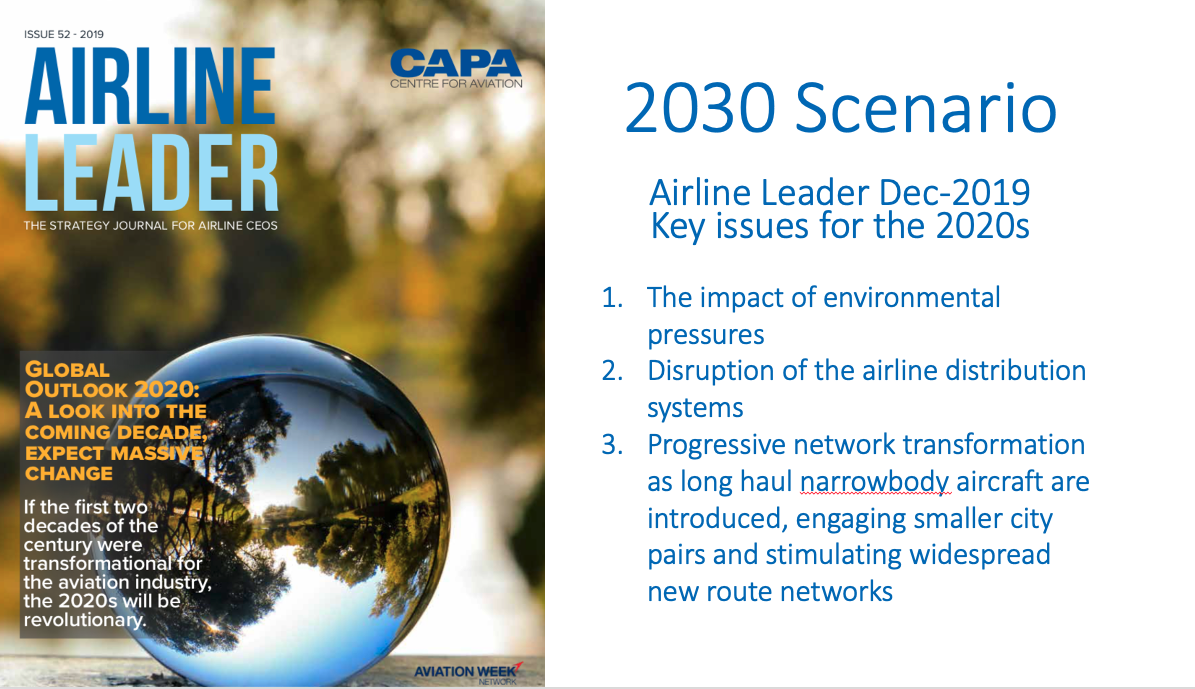
1. Intense environmental pressures will persist
The number one projection was that environmental pressures are going to be immense. Back in December 2019, that was seen as the number one issue for the period to 2030.
2. Distribution disruption
The second point was likely disruption of the airline distribution systems, which is really where the money comes from. Because it's not just about flying and cost. It's about revenues. That system has been in need of disruption for a long time.
3. Network transformation
And then the third major disruptive force, the likely transformation of international networks as long haul, low cost aircraft are introduced to the market.None of those should be particularly controversial, but it’s important, I think, to remember them because we’re so focused on recovering from COVID-19 that it’s perhaps easy to forget these other priorities were there – and they won’t go away.
(In the December 2019 Airline Leader, our fourth major prospect for the decade was the long overdue erosion of national ownership rules. This looks like being a casualty of COVID-19, for the reasons below.)
The new scenario ingredients added in 2020
Return to the 1930s
Then there are some key new scenario ingredients that have arrived this year:
- First of all, the “return to the 1930s”, as we talked about before at CAPA Live in October 2019. The parallel situation of the 1930s, where borders were closed, and passengers were concerned about the safety of flying.
- Secondly, we are entering another uncertain recovery period as the second and third waves of the pandemic hit hard in Europe and the US – and who knows, with more waves to come. There will be many airline failures – and even some consolidation.
International flying is not going to become stable for a long time, let’s face that. These first two features will determine the progress of international flying for at least another year, until predictable border opening is restored and passenger confidence returns.
Consolidation and market exits are inevitable in these circumstances, as debt is mounting massively, and as revenues fail to match that scale.
Cost is really going to become king, as we talked about last month.
Government involvement is inevitably going to increase because many airlines are now invested in by their governments
And there will be greater protectionism emerging as 2021 2022 unfold, and we struggle to recover.
Governments have “invested” in their airlines and may (or even should) feel a taxpayer duty to support their investment.
Business travel has become an endangered species – 60% of business revenues evaporate. And the long haul model must change
Long haul flying is particularly endangered, with loss of business travel revenues and the closure and uncertainty around opening of borders. Since the beginnings of aviation, business and premium travel have underpinned long haul flying. The full service model relies very heavily on that higher-yielding traffic (the experiences of long haul LCCs bore testimony to this as they evolved).
For the full year of 2021, the consensus is that business travel is unlikely even to get back even to 40% of 2019 levels. That’s a massive loss of say 60% of business revenues, business yields, in that they underpin many of the routes that are flown.
In other words, the loss of business traffic completely undermines the long haul model.
Travel system distrust (across the entire travel journey), budget consciousness and working from home also challenge business travel.
Moreover, a recent survey (and there are many surveys, of course) suggested that about two thirds of frequent travellers still distrust the airline system and hotels to protect them adequately from the virus while travelling on business. That’s a real concern, I think.
Added to that we’ve got the pressure from corporate cost-cutting to reduce spending, and thirdly, there is the impact of what we’re doing here today with this virtual event, doing business online; online meetings offer alternatives, much greater than anyone had previously anticipated.
A further, associated factor often overlooked is the combined effect of working from home (WFH) – this too is predicted to have a long future. If, as often suggested, WFH will in future account for around 40% of the average office worker’s week, the greater convenience of virtual connections is further entrenched.
Zooming will certainly feature largely in substituting for business travel in the first two or three years of this decade. As business travel recovers, the proportional impact of virtual operations will progressively be diluted, but the new online doing-business model is here to stay.
To apply some perspective as an indicator, Amazon has saved a billion dollars – USD1 billion – on travel in 2020.
And Amazon is saying that travel will only resume “at a later date”, but that it won’t be spending “at the same levels as the past”. Those are pretty ominous words. It is also a nice fit with environmental responsibility.
The North Atlantic is most affected by the business travel loss
North Atlantic is probably the most sensitive to the loss of business travel. It has been characterised as the world’s most valuable international market, with a very high proportion of business traffic.
The benefits have been concentrated around three large metal-neutral immunised JVs from the three major global alliances: oneworld, SkyTeam and Star. And they’ve had about a 70% to 80% market share. The market has also been characterised by hub-to-hub operations, and the use of mostly widebody equipment.
These features are not going to be the same in future. With business traffic down 40%, 50% or 60% in 2021, that yield profile is going to vanish very quickly.
The JVs will necessarily continue, probably with even more government support, because there is going to be a public service need to make sure those operations can continue, which will distort the market to some extent.
But what we’re likely to see, and this was reinforced in our discussion too with Doug Parker, CEO of American Airlines last month, is the emergence of a higher proportion of smaller gateways served at either end of the North Atlantic market using narrowbody aircraft. Not necessarily in 2021, but increasingly beyond that.
This will really see the market transformed and have a big impact too for airports.
Europe’s full service airlines are most at risk
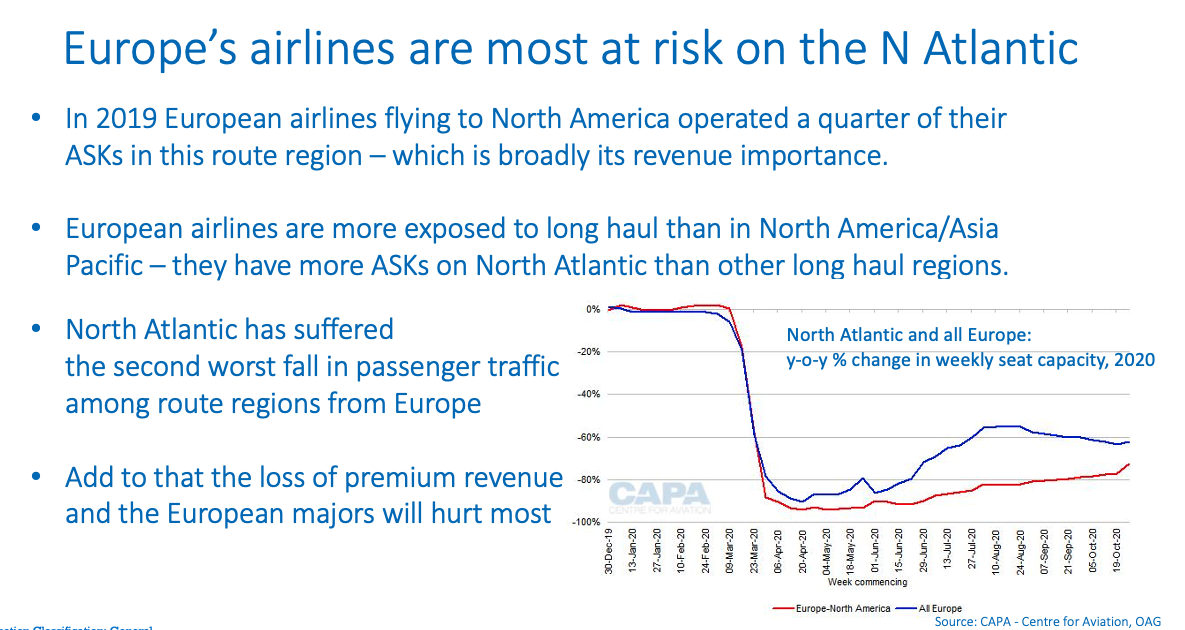
The European airlines rely most heavily on this major route, and none of them has anything like the sort of domestic market that the US carriers can rely on.
About a quarter of the total revenue effectively for the European airlines flying the North Atlantic comes from the North Atlantic market. About a quarter. And if that evaporates, that obviously leaves them heavily compromised.
Moreover, the North Atlantic market has suffered worse than all but one of the route regions from Europe in their COVID-19 impact.
Back to the future. The #1 major issue: climate change and sustainability
“Airlines have been enormously conspicuous for their absence. But they will be vastly more conspicuous for their return.”
These new, COVID-related, ingredients inevitably will force major change on the global airline structure. But they form an overlay, not a replacement of the previous headline points we were anticipating for the 2030s, the impact of environmental pressures.
Airlines have been enormously conspicuous for their absence during COVID-19. I think we must all agree to that. But as they return to the skies, the environmental chorus will become much shriller than before.
There’s a host of environmental forces all ready to resist a full return to flying. And the new base point is very close to zero. It’ll be reset to that level, if not by governments, by popular pressure. That’s an exaggeration, obviously, but it does mean a diminution of the level of expectation, and reduced level of tolerance for airline expansion.
The pressures will come from corporate and investor pressures on our friends from Amazon, for example, who are taking a responsible position on climate change, and with a climate pledge to reduce to a new status quo in terms of business travel and in terms of all forms of travel.
Nor will flight shaming go away, which was so strong in Europe so long ago in 2019. Emission taxes will continue to grow….
Particularly in Europe, where the alternative does exist, short haul substitution by surface will be promoted strongly.
In the UK, there was talk last year of a flying levy or banning frequent flyer programmes because they encouraged travel.
In the US, the new the Biden administration will accelerate the need for alternative fuels, and its policy actually talks in terms of trying to provide some substitution of air services by building a rail network. That’s been talked about a lot in the US, but it’s a central part of the incoming President’s transportation policy.
And generally speaking, I think probably a renewal of concerns about climate change with the major climate-related events that have affected ordinary lives over the last year to 18 months – fires, floods, cyclones and hurricanes.
It’s quite probable in all these circumstances that once airline activity returns to, say, half of its previous levels, as soon as it becomes widely noticeable again, the opposition will greatly intensify.
The #2 major issue: disruption of airline distribution system
This is an interesting and important area for change. Obviously the big GDSs have been massively impacted by the decline in traffic, because their revenues come from unit transaction charges. They were already going through a massive disruption process with the arrival of the New Distribution Capability (NDC) and with the whole challenge to the system with direct selling via airline.com.Importantly now, the early markets to recover will be the domestic ones, where airlines don’t necessarily need the GDSs so actively because brand recognition is strong, and it’s much easier to sell directly in their home market.
It’s an ideal situation really to bypass GDSs. Now, technology has enhanced the ability for online sales or API sales through agents in domestic markets. So airlines that are well-positioned in this will be very much in the front line of change and disruption.
Internationally yes, it’s still going to be important to be able to distribute through more than just the sort of local direct selling network.
But because inevitably, as networks are eviscerated, joint ventures are going to become much more important in restoring networks. They will be much more important in influencing sales processes.
And I would anticipate very strongly that there’ll be more major airline long haul JVs. Restoring key long haul connectivity is going to be difficult, so that governments are likely to be prepared to sacrifice some competitive principles in order to re-establish networks. These JVs will probably be metal neutral, authorised by competition bodies, which means that at each end of any route there will be an airline that does have a domestic market it can sell directly into. And, thanks to the metal neutrality of the JV, the home airline will be happy to sell equally in its respective home market on behalf of its foreign partner.
Digital transformation will be an essential part of adjusting to the future
In all of these circumstances, digitisation is increasingly important. But first, recognising and allocating resources to the specific area is essential. A recent study from McKinsey stressed the importance of reprioritising to adjust to the new environment.
In their case study, many companies had been exploring moving to WFH. Most of the companies they interviewed had previously anticipated that it would take about a year to make the transition.
In actuality, it took around about 11 days to implement what they called a workable solution. The reason that the companies hadn’t done it before for productivity reasons was simply because the priority just hadn’t been allocated to the change.
Today, that priority had leapt up the scale and achieving the goal became surprisingly simple.
And digital innovation can be a game-changer. Airlines that are liquid, who do have some money and can actually spend money on digitisation will be in a much better position to exercise those opportunities.
In achieving this goal, KLM CEO Pieter Elbers believes that financial pressures will push KLM even more towards partnerships with “technology firms with more resources, more knowledge, more capabilities”.
Me Elbers argued technology partners not only increase KLM’s access to investment funds, But also allow it to keep pace with innovation while sticking “to what you’re good at, and that’s running an airline…As an airline, we would not be building our own aircraft”, he says, “so why should we build all our technology ourselves?” See: CAPA Live: KLM CEO straps in for aviation’s bumpy recovery
And the same priority flows through to generating higher cost efficiencies, as well as sales and distribution and leveraging off activities like frequent flyer programmes, which, as we’ve seen in this environment, have become very, very useful.
The #3 major issue: route network transformation is accelerating
Progressive network transformation was the third point in Airline Leader that we looked at for the next decade ahead. There is an enormous number of long haul narrowbody aircraft on order, and once the MAX gets back into operation as well, that number will grow.The LCCs don’t have the monopoly on these aircraft, but each of the major markets will be receiving large numbers of long haul narrowbody aircraft, A321s, MAX’s and the like.
The effects will be transformational.
This was an evolution that was already happening before. COVID is going to accelerate that process, particularly because, in many cases, passengers will prefer to be flying point-to-point rather than going through a hub.
As I mentioned in last month’s CAPA Live, global market shares of LCCs are growing fast. The network transformation is not just about LCCs, but it’s important because they’re actually growing month-on-month as well. Globally, their market share is up to 35% of all seats in the marketplace, up almost 4%.
Globally LCC market share (seats) has increased 3-5% in 2020
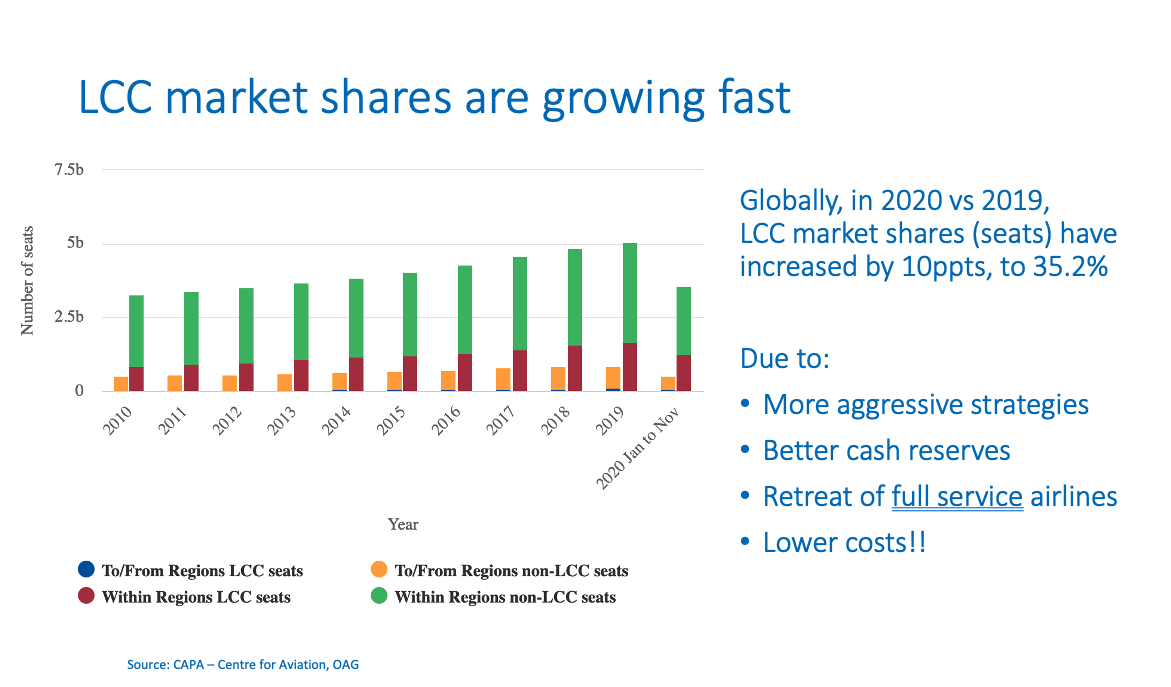
The world’s low cost carriers have mostly been more aggressive with their COVID-19 strategies. They have better cash reserves in most cases, and the full service airlines have retreated more. But also, the LCCs have lower costs, so they can perform better in a low yielding market.
In the US as well, there has been a 4.5% increase year-on-year, in terms of LCC market shares, and the already high 45% share in Europe has increased by almost 2% as well, just in this year.
The rise of China as the leading force has been accelerated by COVID-19
And while all this is going on, the rise and rise of China as an aviation force is continuing apace. Domestic airline figures are back to 2019 levels and higher in some cases.It’s really interesting to see with this bubble chart, just the sort of predictions we’re putting into this. China domestic has currently overtaken US domestic (Note: the N America-North America bubble includes US-Canada travel). That disparity will start to be corrected quickly in late 2021/2022 as conditions settle.
But clearly, China is in a much stronger position with its big domestic market growing still. Its recovery from the coronavirus shutdown is almost complete, while other large domestic markets continue to languish (although it is important to note that China revenues remain depressed as yields stay low).
We’ve made a very modest assumption that China domestic will continue to grow from this level (about 100% of its 2019 level and 50% larger than US domestic, at year-end 2020) at 5% per annum right through the decade.
Meanwhile, with a likely further decline as a new wave of infections washes through in 1Q2021, the US will be subdued in full-year 2021, then resurging in 2022. It’s going to take a long time for US domestic to come back from its current base of less than 50% of 2019.
China's international market will grow rapidly
And at the same time, the Chinese international market will start to grow too, because it's going to be operating Asian regional international services, point-to-point.China is extremely well-positioned geographically to pick up connecting traffic, sixth freedom services, which it can operate off the back of its third and fourth freedom operations, because it has such a large domestic market.
Another positive in the Chinese industry’s future is that its airline industry won’t emerge from the crisis heavily indebted, unlike airlines in most other countries.
Its international market is predominantly outbound, or has been so far, which means that the Chinese carriers are in a much better position to carry that traffic.
It also has a supportive government (as others do), but China’s is particularly supportive.
Its operators are lower cost than most other international airlines. And generally, there is the attitude that “we must go ahead and expand internationally”.
Estimated traffic flow from 2020 to 2030, as presented during CAPA Live, November 11, 2020
By way of contrast, other airlines will in most cases be much more conservative about taking the big risks associated with international services, particularly where revenues are not going to be high. Indeed, with the combined operating handicaps of reduced business travel and the complexity of reopening multiple markets, there is a real possibility of direct government support in one form or another, in order to re-establish key trunk routes.
For these reasons, we see China’s international market outstripping a restored North Atlantic market – currently moribund – by 2024, and even starting to rival its own domestic market, measured in RPKs, by 2030.
It is time to accept some stark realities. Like the threat of terrorism, we will have to learn to live with the virus
So, in conclusion, I think in this recalibrating, this refocusing and restructuring, we've got to recognise some serious facts about the new platform for growth as we approach 2021.• This virus is not going to disappear “like a miracle”.
A lot of people haven’t really accepted this yet: we do need to readapt to this new and compelling scenario, with a whole new attitude. The status quo will not be viable for the future.
The virus is not going to go away in 2021, let alone 2020, as most previous planning had been based on
• As a result, we will be confronted by an airline industry that is considerably smaller and less competitive, those remaining will be heavily indebted, and governments will be more intrusive. Large customer segments will retain levels of concern about flying internationally
• If there are any profitable airlines in the coming years their predominant feature will be their low cost base, as price conscious markets (business and leisure) recover slowly after the initial “pent-up demand” runs its course and recession conditions persist well into 2022
To go back to where I started today, IATA calculated the size of the revenue pool for airlines globally in 2021 will be about half of what it was in 2019. If governments and any airlines are factoring that into their strategic outlooks, that fact is not yet apparent. There is another, very large, shoe still to drop.
2019 levels of activity are still several years, not months, away. It will be a rocky road, particularly if the situation is not recognized for what it is.
A vaccine will be very slow to allow comprehensive international opening up
The path to restoring international air services is not going to be solved quickly by a vaccine.
It is an important breakthrough for aviation on a national level.
Internationally, it’s different. As we’ve seen, governments are going to continue to be very wary of opening borders – and will be quick to close them if the need arises.
(And just as a side note, it did take 20 years to eradicate polio after a vaccine was developed, although this time it will hopefully occur much faster.)
Even distribution of the vaccines faces major logistical, political and financial hurdles (as we’re talking about elsewhere in today’s CAPA Live), and will take at least two years to be distributed globally.
Now, there’ll be some pockets which receive it very, very quickly. Most of the developed nations in fact. That should accelerate the regrowth of their domestic markets. Indeed, for those countries with large domestic markets it will provide a great tailwind.
But it’s still going to be very difficult to open up international markets, unless everybody is vaccinated. And until several billion people can be vaccinated, the border situation will remain uncertain and, most likely, fragmented.
International cooperation is more important than any vaccine
In the meantime, universal testing, tracing, commonality of standards, and multilateral cooperation is going to be so vital in this process. They will be the primary foundation for reopening borders. That foundation has not yet been designed, let alone built.
International cooperation will be key. And we haven’t seen enough of it so far.
So that’s where we are. Hopefully, that does lay out some new ideas about anticipating where our new foundation is for growth through the 2030s.
If our assessment appears pessimistic, I would argue it’s more realistic than not.
Without diagnosing the problem there’s no prospect of finding the key to its solution.
Blindly trying to restore a 2019 status quo will only lead to tears.
More Travel News:
IATA launches new exchange for offsets trading
IATA calls on governments to support industry move to SAF
JetBlue to host next AGM in Boston
G Adventures: Travel with Confidence into 2021











